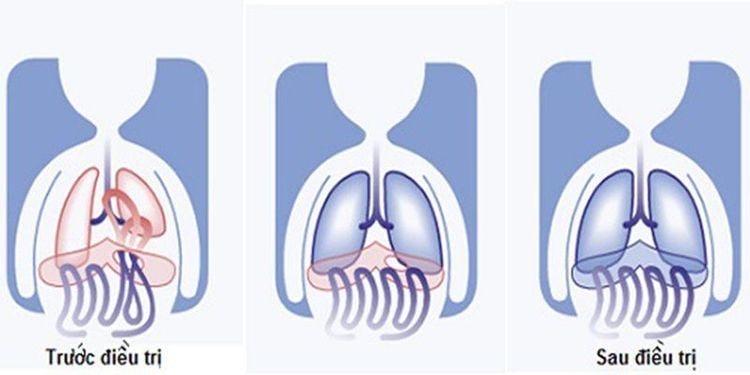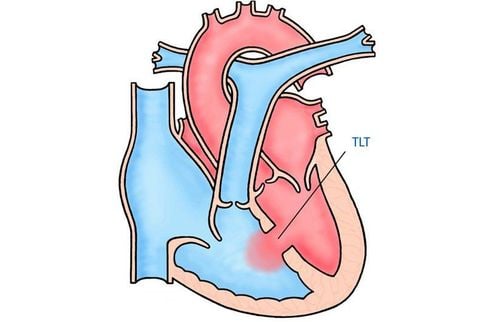This is an automatically translated article.
Congenital diaphragmatic hernia through the posterior lateral foramen (Bochdalek) is a condition in which intra-abdominal viscera ascend to the thorax due to a defect in the posterior foramen of the diaphragm, causing pulmonary compression. The only treatment for congenital diaphragmatic hernia is surgery.
1. What is congenital diaphragmatic hernia?
Diaphragmatic hernia is a pathological lesion of the diaphragm through which intraperitoneal viscera move up into the thoracic cavity through the openings of the diaphragm. Diaphragmatic hernia can be congenital or acquired. Accordingly, this congenital pathology is often detected during pregnancy or infancy. Posterior posterior foramen hernia accounts for 95% of congenital cases, this type of congenital diaphragmatic hernia was first reported in 1848 by Victor Alexander Bochdalek, hence the name Bochdalek hernia. Children with congenital diaphragmatic hernia are often accompanied by varying degrees of respiratory failure (inefficient breathing) because the lungs and pulmonary blood vessels on the side of the diaphragmatic hernia are underdeveloped.
2. Diagnosis of congenital diaphragmatic hernia
2.1. Clinical Partial or total diaphragmatic defect Patient has signs of respiratory distress: tachypnea, cyanosis, which may occur soon after birth or a few hours after birth, even later with recurrent pneumonia broadcast. Chest examination: unilaterally reduced alveolar murmur, intrathoracic bowel sounds, right apex heart sound. Concave abdomen.

Trẻ bị suy hô hấp sau khi sinh vài giờ
2.2. Subclinical chest X-ray showed a gas bubble of the stomach or intestines in the chest, the mediastinum was pushed to the opposite side, no diaphragmatic dome was visible. Contrast X-ray of the stomach: this test is indicated in cases where the chest X-ray has not confirmed the diagnosis. Thoracic and abdominal ultrasound: shows images of some organs in the abdomen located in the ribcage. Echocardiography: right deviation of the heart, assessment of pulmonary artery pressure, and combined congenital heart defects. Arterial blood gases are also needed in pediatric patients with respiratory failure.
3. Surgical treatment of congenital diaphragmatic hernia (Bochdalek)
Currently, surgery is the only method to treat congenital diaphragmatic hernia. The purpose of surgery is to return the herniated viscera to the peritoneal cavity and restore the diaphragm. Surgery can be laparoscopic or open surgery. Laparoscopic surgery is preferred because of its advantages over open surgery.
Steps to perform surgery include:
Endotracheal anesthesia, muscle relaxation. Stage 1: laparotomy, exploration Open surgery: make an incision in the middle white line above the navel. Laparoscopic surgery: place a 10mm trocar through the navel, inflate to bring the camera into the abdomen for exploration. Place 2 more 5mm trocars below the flanks on both sides to bring the instruments into surgery. Stage 2: push the herniated viscera to the chest and return to the abdomen. Stage 3: suture to restore the diaphragmatic hole Sew up the hernia hole with non-absorbable sutures If the hernia hole is quite large or the whole diaphragm is defective: the surgeon must use artificial or autologous grafts such as muscle fascia, muscle flap nearby to replace diaphragm. Close abdomen, withdraw trocar, end surgery.

Điều trị thoát vị hoành bẩm sinh bằng phẫu thuật
4. Post-operative care
After surgery, the patient is transferred to the recovery department, the body is kept warm, the head is elevated, respiratory support is provided. The doctor will check blood gas 1 hour after surgery and chest X-ray 6 hours after surgery, continue to give intravenous antibiotics for 7-10 days. Patients must fast from the gastrointestinal tract, receive complete intravenous nutrition for 2-3 days, then feed by mouth or through a nasogastric tube. The patient received daily wound care and sutures removed after 7 days.
Vinmec International General Hospital is one of the general hospitals that ensures the quality of medical examination and treatment expertise and is famous for its comprehensive examination and treatment services. With a team of highly qualified doctors and nurses with many years of experience in the profession, they will provide the best treatment plan as well as advice on the best health for the patient.
Customers can directly go to Vinmec Health system nationwide to visit or contact the hotline here for support.













